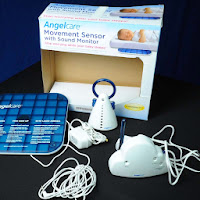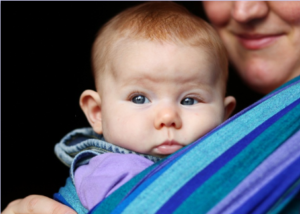New study explains why babies calm down when they are carried.
Every parent and caregiver knows from first hand experience that babies calm down when they are picked up, gently rocked, and carried around the room. New research published in the journal Current Biology on April 18, 2013 shows that this is a universal phenomenon. Infants experience an automatic calming reaction when they are being carried, whether they are mouse pups or human babies.
"From humans to mice, mammalian infants become calm and relaxed when they are carried by their mother," says Kumi Kuroda of the RIKEN Brain Science Institute in Saitama, Japan. Being held in a mother's arms is the safest place for a baby to be, and the mother can have peace of mind knowing her baby is happy, content, and relaxed. The fact that babies are neurobiologically wired to stop crying when carried is a part of our evolutionary biology that helps our species survive.
This study is the first to show that the infant calming response to carrying is a coordinated set of central, motor, and cardiac regulations that is an evolutionarily preserved aspect of mother-infant interactions, the researchers say. It also helps to have a scientific explanation for the frustration many new parents struggle with. . . a calm and relaxed infant will often begin crying immediately when he or she is put down. When my daughter was young, swaddling her seemed to create a compact posture and sense of security that triggered an automatic relaxation response when she was put back down and helped break this cycle.
What triggers this calming response?
Kuroda and colleagues at RIKEN determined that the calming response is mediated by the parasympathetic nervous system and a region of the brain called the cerebellum (Latin: little brain). The researchers found that the calming response was dependent on tactile inputs and proprioception. Proprioception is the ability to sense and understand body movements and keep track of your body's position in space. They also found that the parasympathetic nervous system helped lower heart rate as part of mediating the coordinated response to being carried.
Both human and mouse babies calm down and stop moving immediately after they are carried, and mouse pups stop emitting ultrasonic cries. Mouse pups also adopt the characteristic compact posture, with limbs flexed, seen in other mammals such as cats and lions.
The idea that the familiar calming dynamic was also playing out in mice occurred to Kuroda one day when she was cleaning the cages of her mouse colony in the laboratory. She says, "When I picked the pups up at the back skin very softly and swiftly as mouse mothers did, they immediately stopped moving and became compact. They appeared relaxed, but not totally floppy, and kept the limbs flexed. This calming response in mice appeared similar to me to soothing by maternal carrying in human babies."
The Role of the Cerebellum in Calmness
As an athlete, I have written extensively about the cerebellum and its role in coordinating fine-tuned muscle movements, balance, and proprioception... The cerebellum is always on guard to protect your body from danger and prepare you for 'fight-or-flight' by keeping track of everything going on in your environment.
Among many other jobs, the cerebellum has a huge responsibility to maintain your safety and physical well being. This takes a lot of brain power and energy. Although the cerebellum is only 10% of brain volume it holds over 50% of your brain's neurons. Neuroscientists are perplexed by everything that the cerebellum does. This study offers one more valuable clue.
Scientists have known for years that the cerebellum is directly linked to a feedback loop with the vagus nerve which keeps heart rate slow and gives you grace under pressure. As adults, we can calm ourselves by practicing mindfulness and Loving-Kindness Meditation which puts the cerebellum at peace and creates a parasympathetic response of well being. This appears to be the same response that occurs in infants when they are being carried.
Interestingly, the only time during the day that the cerebellum is allowed to let down it's guard and go offline is during REM sleep when your body is paralyzed to prevent you from acting out your dreams. It makes sense that being picked up and carried would send automatic signals that allow the cerebellum to relax and create healthy vagal tone which would lower heart rates in infants.
Conclusion
The researchers believe that these findings could have broad implications for parenting and contribute to preventing child abuse. “This infant response reduces the maternal burden of carrying and is beneficial for both the mother and the infant," explains Kuroda. She goes on to say, “Such proper understanding of infants would reduce frustration of parents and be beneficial, because unsoothable crying is a major risk factor for child abuse.”
"A scientific understanding of this infant response will save parents from misreading the restart of crying as the intention of the infant to control the parents, as some parenting theories—such as the 'cry it out' type of strategy—suggest," Kuroda says. "Rather, this phenomenon should be interpreted as a natural consequence of the infant sensorimotor systems." If parents understand that properly, perhaps they will be less frustrated by the crying, Kuroda says. And that puts those children at lower risk of abuse.
The authors conclude that, “Although our study was done on mothers, we believe that this is not specific to moms and can be used by any primary caregiver.”
This article can be found here.















